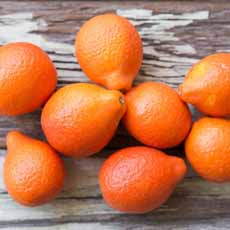FOOD FUN: Mandarinquats
 [1] Mandarinquats at Eataly | Chicago (photo courtesy Eataly).
|
Cross-breeding fruits and vegetables to discover a desirable hybrid is an ongoing task among breeders everywhere. (Hybridization is the same as cross-breeding.) You may have come across apriums and plucots, both of which are crosses of apricots and plums, with different percentages of genes. We just saw our first mandarinquat, a cross between an mandarin and a kumquat. The hybrid created a very juicy, larger fruit. “If you’re into tart fruit, this is a great one to eat out-of-hand, but it also lends itself to preserving, juicing or zesting,” says Good Eggs, which retails the fruit. They suggest using a mandarinquat instead of an orange or lime in cocktails for some added acidity. The fruits in photo #2 were grown at Deer Creek Heights Ranch in Porterville, California. We always drool at the produce of Good Eggs, which, from its headquarters in the Bay Area of California, has access to many dedicated family farmers who grow wonderful produce. Our idea of a vacation: Head to the Good Eggs warehouse and walk up and down the aisles for a taste-a-thon. (That’s just a fantasy—the company is a delivery service only.) Plant breeding dates back to the domestication of the first agricultural plants, somd 9,000 to 11,000 years ago. Early farmers selected plants with desirable characteristics and used their seeds to propagate subsequent generations. Over time, a better plant was produced: hardier, bigger, tastier, etc. |
|
|
In modern times, the science and understanding of genetics, and how to crossbreed, was established by the Augustinian monk and scientist Gregor Mendel (1822-1884). Today, plant breeding goes beyond genetics, with a scientific basis that incorporates molecular biology, cytology, systematics, physiology, pathology, entomology, chemistry, and biometrics. Here’s more about it. |
||



